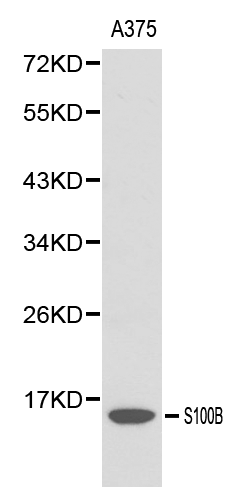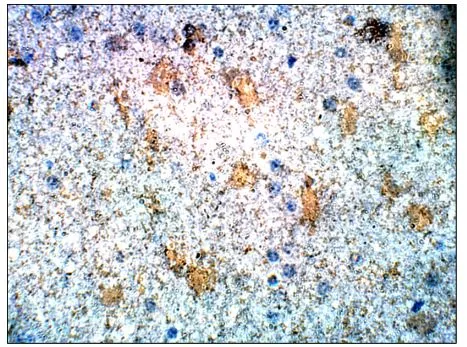S100 beta antibody
GTX129573
ApplicationsImmunoFluorescence, Western Blot, ImmunoCytoChemistry, ImmunoHistoChemistry, ImmunoHistoChemistry Frozen, ImmunoHistoChemistry Paraffin
Product group Antibodies
TargetS100B
Overview
- SupplierGeneTex
- Product NameS100 beta antibody
- Delivery Days Customer9
- Application Supplier NoteWB: 1:500-1:3000. IHC-P: 1:100-1:1000. IHC-Fr: 1:100-1:1000. *Optimal dilutions/concentrations should be determined by the researcher.Not tested in other applications.
- ApplicationsImmunoFluorescence, Western Blot, ImmunoCytoChemistry, ImmunoHistoChemistry, ImmunoHistoChemistry Frozen, ImmunoHistoChemistry Paraffin
- CertificationResearch Use Only
- ClonalityPolyclonal
- Concentration0.14 mg/ml
- ConjugateUnconjugated
- Gene ID6285
- Target nameS100B
- Target descriptionS100 calcium binding protein B
- Target synonymsNEF, S100, S100-B, S100beta, protein S100-B, S-100 calcium-binding protein, beta chain, S-100 protein subunit beta, S100 calcium-binding protein, beta (neural)
- HostRabbit
- IsotypeIgG
- Protein IDP04271
- Protein NameProtein S100-B
- Scientific DescriptionThe protein encoded by this gene is a member of the S100 family of proteins containing 2 EF-hand calcium-binding motifs. S100 proteins are localized in the cytoplasm and/or nucleus of a wide range of cells, and involved in the regulation of a number of cellular processes such as cell cycle progression and differentiation. S100 genes include at least 13 members which are located as a cluster on chromosome 1q21; however, this gene is located at 21q22.3. This protein may function in Neurite extension, proliferation of melanoma cells, stimulation of Ca2+ fluxes, inhibition of PKC-mediated phosphorylation, astrocytosis and axonal proliferation, and inhibition of microtubule assembly. Chromosomal rearrangements and altered expression of this gene have been implicated in several neurological, neoplastic, and other types of diseases, including Alzheimers disease, Downs syndrome, epilepsy, amyotrophic lateral sclerosis, melanoma, and type I diabetes. [provided by RefSeq, Jul 2008]
- Storage Instruction-20°C or -80°C,2°C to 8°C
- UNSPSC12352203
References
- Takenaka T, Ohnishi Y, Yamamoto M, et al. Glycolytic System in Axons Supplement Decreased ATP Levels after Axotomy of the Peripheral Nerve. eNeuro. 2023,10(3):pii: ENEURO.0353-22.2023. doi: 10.1523/ENEURO.0353-22.2023.Read this paper
- Russell DF, Zhang W, Warnock TC, et al. Lectin binding and gel secretion within Lorenzinian electroreceptors of Polyodon. PLoS One. 2022,17(11):e0276854. doi: 10.1371/journal.pone.0276854Read this paper
- Allaf A, Victoria B, Rosario R, et al. WP1066 induces cell death in a schwannomatosis patient-derived schwannoma cell line. Cold Spring Harb Mol Case Stud. 2022,8(4). doi: 10.1101/mcs.a006178Read this paper
- Degl'Innocenti E, Poloni TE, Medici V, et al. Centrin 2: A Novel Marker of Mature and Neoplastic Human Astrocytes. Front Cell Neurosci. 2022,16:858347. doi: 10.3389/fncel.2022.858347Read this paper
- Mathews J, Kuchling F, Baez-Nieto D, et al. Ion Channel Drugs Suppress Cancer Phenotype in NG108-15 and U87 Cells: Toward Novel Electroceuticals for Glioblastoma. Cancers (Basel). 2022,14(6). doi: 10.3390/cancers14061499Read this paper
- Russell DF, Warnock TC, Zhang W, et al. Large-Scale Convergence of Receptor Cell Arrays Onto Afferent Terminal Arbors in the Lorenzinian Electroreceptors of Polyodon. Front Neuroanat. 2020,14:50. doi: 10.3389/fnana.2020.00050Read this paper
- Kumagai K, Toyooka T, Takeuchi S, et al. Hydrogen gas inhalation improves delayed brain injury by alleviating early brain injury after experimental subarachnoid hemorrhage. Sci Rep. 2020,10(1):12319. doi: 10.1038/s41598-020-69028-5Read this paper
- Bronzuoli MR, Facchinetti R, Ingrassia D, et al. Neuroglia in the autistic brain: evidence from a preclinical model. Mol Autism. 2018,9:66. doi: 10.1186/s13229-018-0254-0Read this paper
- Logan SM, Storey KB. Pro-inflammatory AGE-RAGE signaling is activated during arousal from hibernation in ground squirrel adipose. PeerJ. 2018,6:e4911. doi: 10.7717/peerj.4911Read this paper
- Niimi N, Yako H, Takaku S, et al. A spontaneously immortalized Schwann cell line from aldose reductase-deficient mice as a useful tool for studying polyol pathway and aldehyde metabolism. J Neurochem. 2018,144(6):710-722. doi: 10.1111/jnc.14277Read this paper







![IHC-P analysis of human brain, cerebellun using GTX83327 S100 beta antibody [9A11B9].](https://www.genetex.com/upload/website/prouct_img/normal/GTX83327/GTX83327_20170912_IHC-P_1_w_23061322_688.webp)
